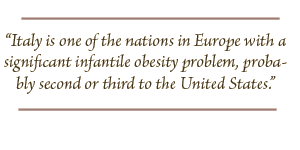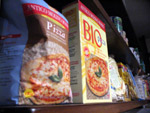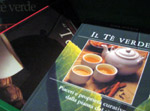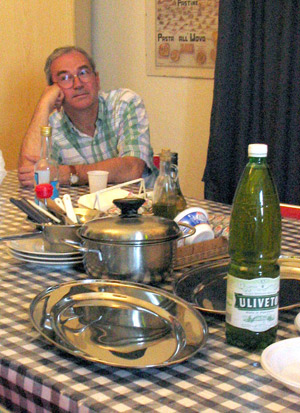 |
|
 |
| In the grocery markets in Cagli, pastas, breads,
and cookies line the shelves and dominate the stores. Contrary to
the new high protein/low carbohydrate phenomenon, pasta-passionate
Italians, including people in Cagli, have not given up their love
for homemade cappelletti and gnocchi. It is a part of their cultural
identity. However, Corvaglia said, “one of the major causes of death
is cardiovascular disease. Nutrition plays a major role in this
disease, in particular an excess consumption of fats, which causes
high blood pressure and other problems.” Besides pasta products, other popular cooking ingredients are “tomatoes
and olive oil,” said Franco Pazzaglia, owner of La Lanterna
Trattoria. Pazzaglia describes the most popular dishes at his restaurant
as “handmade cappelletti and tagliatelle,” which can
be served with lean pork, veal and turkey. Just as pasta and pizza are more popular than salad or meat dishes, wine is more popular than sodas or tea. He said, “About two glasses to each customer is the normal request during dinner.” |
 |
 |
 |
Awareness of health problems
has convinced many Cagliesi to change their eating habits. Patrizia Scaglione opened her store La Bottegga Della Erbe, or
The Little Shop of Herbs, 18 years ago because she believed that
more nutritious food could improve a person’s overall health.
She says that she has noticed an increased awareness of health among
people in Cagli in recent years, and she has since expanded the
variety of foods in her store. Although women 25-60 years old are her most frequent customers,
the store advocates the health of both women and men. Specific health
needs are also taken into account: Scaglioni offers sugar-free biscotti
to her diabetic customers, as well as gluten-free pasta to those
allergic to the compound. Specific items that she offers are cookies that replace sugar with natural juice or malt, rice milk, and pasta made with unbleached and unwashed flour. Her organic foods have no insecticides or preservatives. |
 |
|
 |
Scaglione said she has noticed a trend that health problems initially
motivate her customers to adopt healthier eating habits. One customer, Romina Pierfranceschi, said she buys food from this
store because she is “concerned with her child’s health”
and is interested in preventing potential future health problems.
According to Corvaglia, “Italy is one of the nations in Europe with a significant infantile obesity problem, probably second or third to the United States. The reason for this is that parents from about 20 years ago came from impoverished childhoods and decided to feed their children as much as they could as a reaction.” |
 |

|
 |
A May 13, 2004, World Health Organization
report says that “36 percent of nine-year-olds in mainland
Italy and Sicily were overweight or obese.” When Italians eat sweets, it is usually a weekend or morning treat,
said Cagli baker Barbara Patrignani. “More desserts are made and sold on Sundays, but biscotti
are eaten by most people every morning,” said Patrignani,
whose family owns the Pani Ficuo Ricci bakery. “Bread is our most popular item, followed by the biscotti cookies that people eat for breakfast,” she added. Her goods are baked with “00 flour,” (which is finer than regular flour), sugar, butter, natural lemon and vanilla extracts, and eggs.
|
 |
Click here to see "Cooking Gnocchi Cagliese Style" Story by: Cheryl Trovato Web Design by: Candace Cage Photos by: Gina Licari Video by: Cook Alciati |
|


